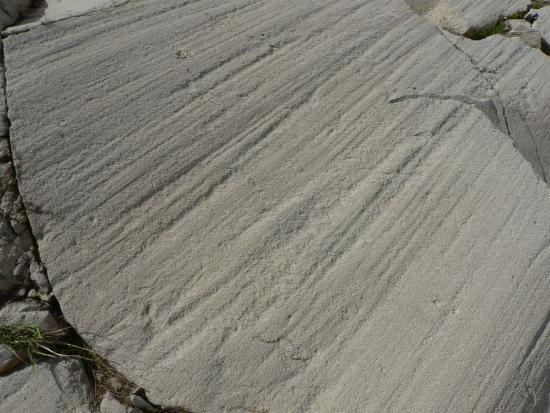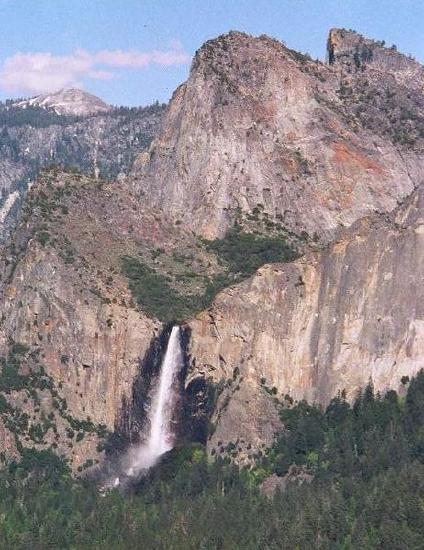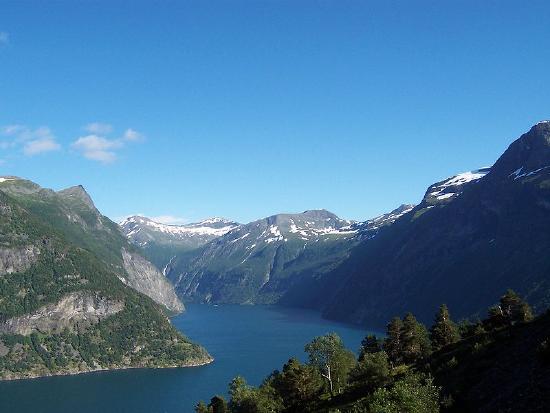Glacial Erosion
- Page ID
- 10881
What is glacial erosion?
In glacial environments, the primary form of erosion is physical. Physical erosion is caused by the breaking up of rocks without changing their chemical composition. There is very little to no chemical weathering occurring in glacial environments due to the low temperatures. Glacial erosion can physically change rocks in many ways, such as the following major ways:
- Ice can freeze in the cracks of rocks after rain, causing the ice to expand the cracks and lead to pieces of rock breaking off
- Flow of glaciers “plucking” rocks up from the base of the flow
- As the ice flows through glacial valleys they grind against the floor, along with other rocks
Fig 1. (https://commons.wikimedia.org/wiki/F...glaciar-en.svg)
What do the effects of glacial erosion look like?
The above listed examples can contribute to the way glacial erosion influences landscapes by carrying many small pebbles to large boulder sized rocks and clasts. Their most prominent effects are listed as follows:
- Rocks with smoothed off faces from dragging against other rocks, also known as faceted clasts.
- Striations and grooves within rocks due to the dragging or scraping across of rocks being carried by glaciers.
- Glacial pavements that cause valleys to be smoothed off and flat due to glacial flow.
- Rock flour, which formed from the bits of rock that are abraded off as facets, striations, grooves, and glacial pavements.
- Glacial polish, which is caused when rocks or pebbles in glaciers slide across bedrock leaving it smooth.

Fig 2: Glacial striations left on bedrock in a glacial valley (https://commons.wikimedia.org/wiki/F...tion_21145.JPG)
Geomorphic Glacial Structures caused by Erosion
While glacial erosion can cause striations and other effects to bedrock, it can also form geomorphic structures. These structures are seen very frequently where there were once glaciers and are very common in glacial valleys.
- Cirques are caused when glaciers erode into mountains, causing bowl-shaped and amphitheater-like depressions.
- U-shaped valleys, or troughs, are caused as glaciers flow through v-shaped valleys previously carved by rivers. These sharp, narrow v-shaped valleys are then widened and steeper from the glaciers flowing through eroding the sides and bottom.
- Fjords are narrow inlets to the ocean that become steeper and wider due to glacial flow and erosion. Their walls are similar to that of U-shaped valleys, however they have floors below sea level and are thus full of water.
- Hanging valleys, shown in figure 3, are formed when a smaller glacier joins a larger valley glacier. These two glaciers have different depths (with the smaller glacier being shallower than the larger glacier) which when the glaciers have melted or retreated, causes the floor of the smaller glacier to be up higher above the valley floor. Waterfalls are common when rivers flow through hanging valleys.
- Moraines are the leftover material from glaciers. This consists of soil and rock that is deposited as glaciers move and melt. There are four different kinds of moraines classified depending on where they formed in or on the glacier: lateral moraines (at the top of the glacier's edge), medial moraines (on top of and inside glaciers), superglacial moraines (on top of glacier), and terminal morianes (at the end of a glacier).
Fig 3: Hanging valley in Yosemite NP. Fig 4: Fjord in Norway. (https://commons.wikimedia.org/wiki/F...gian_Fjord.jpg)
Where can effects of this phenomenon be seen in the world?
A particularly relevant area to Californians and hikers alike dominated by glacial erosion is that of Yosemite National Park. Tuolumne Meadows, located inside Yosemite NP, is a popular spot for rock climbers due to its large vertical rock faces. Tuolumne River runs through the park and cut the area into a V-shaped valley before a global cooling trend caused it to freeze over. Yosemite was then carved by a glacier, leaving a large U-shaped valley between the Sierra Nevada Mountains. Since it is dominated by glacial activity, most of the exposed bedrock is polished granite and there are a number of glacial lakes, rivers, and waterfalls. These are all the left over effects of glacial erosion and then melting, filling in those carved out areas. The steep walls of Tuolomne Meadows and many other popular climbing locations are due to the way the glaciers flowed through the previously glacially dominated area, leaving the high steep rock formations behind long after the glaciers had already retreated. Glacier National Park, in Montana, is dominated by sedimentary rocks overlain by magma instead of granites, but two million years ago was similarly dominated by these "rivers of ice". Glacier NP is characterized by multiple U-shaped valleys, cirques, and moraines. The park also currently has upwards of 20 alpine glaciers that have formed within the past 6,000 years.
Fig 5: Half Dome in Yosemite National Park, CA. Fig 6: Iceberg Cirque in Glacier National Park, MT. (https://commons.wikimedia.org/wiki/F...P_-_Diliff.jpg) (https://commons.wikimedia.org/wiki/F...erg_Cirque.jpg)
Sources:
https://commons.wikimedia.org/wiki/F...tion_21145.JPG
https://commons.wikimedia.org/wiki/F...osemite_NP.JPG
https://www.nps.gov/articles/cirques.htm
https://www.nationalgeographic.org/encyclopedia/moraine/
Becker, Richard A.; Tikoff, Basil; Riley, Paul R.; and Iverson, Neal R., "Preexisting fractures and the formation of an iconic American landscape: Tuolumne Meadows, Yosemite National Park, USA" (2014). Geological and Atmospheric Sciences Publications. 151.
https://lib.dr.iastate.edu/ge_at_pubs/151






